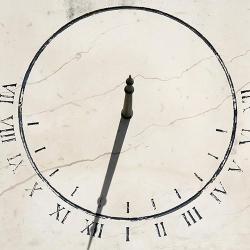Source Institutions
Source Institutions
Add to list Go to activity

Learners construct one or more of the following kinds of sundials: a shadow plot, a horizontal sundial, and a diptych sundial. They track the position of the sun during the course of a day, and use their sundials over the course of several days or even weeks. Learners investigate the accuracy of sundials and the discrepancy that lies between "real time" and "clock time."
- Under 5 minutes
- 1 to 7 days
- $1 - $5 per student
- Ages 11 - 14
- Activity, Experiment/Lab Activity
- English
Quick Guide
Materials List (per student)
- 1 piece of large white paper
- pencil width wooden dowel (or similar) 30-38 cm (12"-15")
- ball of clay
- duct tape, eight 3" strips
- permanent marker
- timer
- small wooden disk
- 3/4"-1" nail
- pencil
- pen
- pair of scissors
- index card
- hammer
- protractor
- sheet of paper
- (optional) string
- wood glue
- template for diptych assembly
- 1 piece of heavy paper
- glue
- string, preferably elastic
Subjects
-
Earth and Space Science
- Earth Structure
-
Earth, Moon and Sun
- Days
-
Solar System
- The Sun
-
Engineering and Technology
-
Technology
- Information and Communication
-
Technology
-
Mathematics
-
Data Analysis and Probability
- Data Analysis
- Data Collection
-
Measurement
- Units of Measurement
-
Data Analysis and Probability
-
The Nature of Technology
-
The Design Process
- Troubleshooting and Maintenance
-
The Design Process
Informal Categories
- Outdoor Activity
Audience
To use this activity, learners need to:
- see
- touch
Learning styles supported:
- Involves hands-on or lab activities
Other
Components that are part of this resource:
Includes alignment to state and/or national standards:
Includes assesments for student learning:
This resource is part of:
Access Rights:
- Free access
By:
- Center for Engineering Educational Outreach, Tufts University
Source Collection
- TeachEngineering
Rights:
- All rights reserved, Regents of the University of Colorado, 2013
